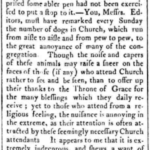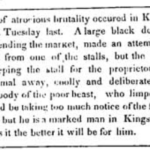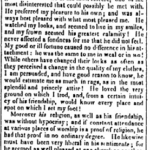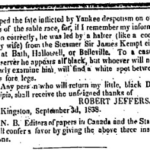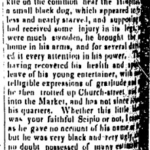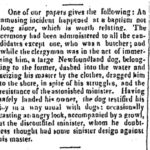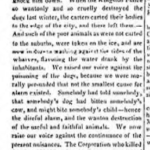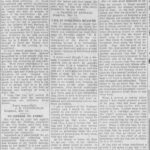Street Address: 270 King Street, St George’s Church
Dogs’ relationship to the city has undergone dramatic changes. Some 200 years ago, dogs were much more mobile and independent, navigating the city according to their own schedules and surviving largely by scavenging and stealing food. This sometimes meant that dogs disrupted human events and practices. Take for example, the dogs who generated complaint in 1819 because they ran “from aisle to aisle and from pew to pew” in churches, such as St George’s, where this event likely took place.[1] At the time of this story, St George’s Church was a small wooden structure (40X32 feet) opposite the Market Square.[2] The ramifications for dogs not following the rules or social conventions were often deadly. For example, in 1834 a man stabbed and killed a farmer’s dog in the market square because he had stolen some meat.[3]
In the 1840s the city established campaigns to eradicate free-roaming dogs through mass poisonings. Many Kingstonians objected to the practice – some thought it was inherently cruel, while others despised the foul stench left by dogs’ decaying bodies.[4] A local resident wrote to the British Whig in May 1847 saying that Kingston was a “sweet-smelling city” but that the dogs who were killed the year before had fallen into water tanks, frozen over the winter, and were now thawing, creating a foul stench. They implored that “The Corporation who killed the dogs should order the instant removal of their putrid carcasses” because “dead dogs taint the air and disease the water.” Perhaps it was in response to some of these complaints that the city started requiring dogs to wear collars in 1847, and later began burning their dead bodies in the city’s incinerator. In 1916, 90 dogs had been incinerated by the city and by 1923 it had risen to 123.[5]
One of the main justifications for restraining dogs was fear of rabies but also that dogs would eat other animals considered economically valuable, like sheep.[6] Human-dog relations in Kingston have not, however, only been characterised by violence and control. In historical newspapers, there are numerous examples of care and concern expressed by both dogs and humans. In September of 1838, for example, a large black Newfoundland dog was written about in the Chronicle and Gazette: he kept pulling his human out of the water during a religious ceremony because, according to the onlooker, the dog thought the minister had “some sinister design against his master.”[7] In the same year, Robert Jeffers wrote a touching story looking for his “lost friend”, Scipio whose friendship was “without hypocrisy and who accompanied him to every meeting.”[8] In 1927 many Kingstonians were drawn into fierce debate about the increasing use of legislation to curtail the movement of dogs such as one-woman who said “It seems strange, then, that a perfectly harmless dog, doing no injury to anyone or anything should not be allowed a little freedom.” [9]
Today Kingston is home to many dogs most of whom are leashed, owned, and largely confined to homes or fenced yards. A growing number of services are available for dogs such as grooming, health care, day care, agility and citizenship classes, as well as dog parks. These reflect the shift towards seeing dogs as ‘members’ of the family and community, but the question of “freedom” persists. While dogs are increasingly valued as members of Kingstonian society they are still subjected to severe limits on mobility, and various practices to make them ‘conform’ to human expectations concerning location, appearance, and behaviour. Dogs have been a part of Kingston since the beginning, though the ways in which the city relates to them have changed considerably. What do dogs’ futures in the city of Kingston look like?
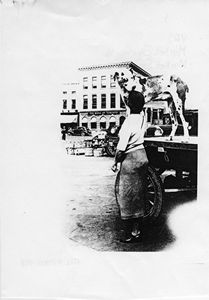
Notes and Credits:
Footnotes:
- [1] Letter to the editor of the Kingston Chronicle about dogs in church, 5 November 1819, “For the Kingston Chronicle,” The Kingston Chronicle. Page 3.. The article does not specify which church is being referred to but St. George’s was present from 1794 (wood) and rebuilt (1825-28) in stone. St. Andrews was built 1822 and St. Mary’s was not constructed until 1842 so it was likely St. George’s.
- [2] “St George’s Cathedral and Revered John Stuart,” Available from Stones
- [3] 22 August 1834, Untitled article about a dog stabbing. The Daily British Whig. Page 2. Col 4. Available from Digital Kingston
- [4] 21 May 1847, “Dead dogs,” The British Whig. Page 3.
- [5] See references to the number of dogs put in the incinerator in the Sanitary Inspector Reports, he reports to both the Board of Health and the Garbage Committee about the incinerator (Board of Health Correspondence, Box 245, Queen’s University Archives).
- [6] Board of Health Correspondence, Box 245, Queen’s University
- [7] 29 September 1838 an untitled article in the Chronicle and Gazette about “an amusing incident.”
- [8] 5 September 1838, an article written by Robert Jeffers titled “A Serious Misfortune” about his lost friend Scipio. In The Chronicle and Gazette. Page 3.
- [9] 5 December 1927, “Citizens write Whig-Standard Editor on curtailing dogs’ freedom,” The Kingston Whig-Standard. Page 4.
Extras:
- Inside of a Dog: What dogs see, smell and know by Alexandra Horowitz;
- Our Dogs, ourselves: The Story of a Singular Bond by Alexandra Horowitz;
- Being a Dog: Following the Dog Into a World of Smell by Alexandra Horowitz
- Canine Confidential: Why Dogs Do What They Do, by Marc Bekoff
- Dog, by Susan McHugh
- How dogs work, by Raymond Coppinger and Mark Feinstein
- Dogopolis: How Dogs and Humans Made Modern New York, London, and Paris, by Chris Pearson.
- Pets in America: A History, by Katherine C. Grier
- Moscow’s Stray Dogs Master Using the Subways, a short clip from ABC News Documentary
- Stray, a film by Elizabeth Lo
- Space Dogs, a film by Elsa Kremser & Levin Peter
- A brief history of dogs, a mini documentary from National Geographic
- Off Leash, a podcast by Alexandra Horowitz


